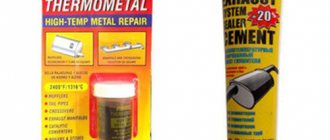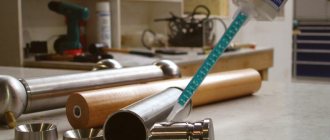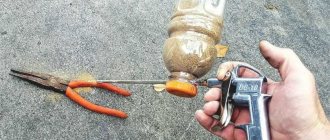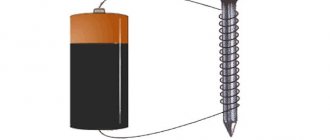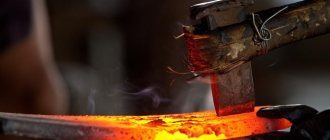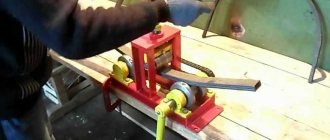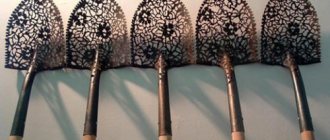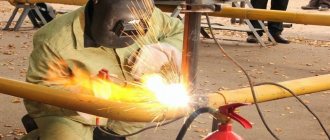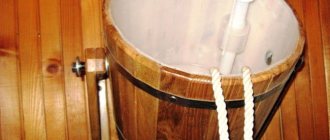Currently, there are many different adhesive compositions on the market, sold under the general name “Cold Welding”. In reality, such compositions have nothing in common with either hot or cold welding. Under this trade name, polymer composite materials are sold that can be used to repair products made from a wide variety of materials - from metals to wood, ceramics, glass and plastic. Sometimes it becomes necessary to remove such glue. The reasons for this can be very different. If such a need arises, you can dissolve the cold weld without any problems or remove it using other methods.
Cold welding can be used to repair any materials and products.
How to use cold welding for plastic?
The cold welding process itself is very simple. To do this, the surfaces to be bonded must be sanded with sandpaper to increase the roughness, which affects the adhesive properties of the plastic. After which degreasing must be carried out; for this you can use any alcohol-based solution.
Interesting materials:
How to freeze raw chanterelles? How to Password a Photo Album on an iPhone? How to burn files to disk using Nero? How to burn a movie from a DVD to a flash drive? How to record video from Samsung s20 screen? How to record a video from Skype to a computer? How to make an appointment with bailiffs for public services? How to sign up to take the GTO standards? How to sign up for MFC in Tula? How to record lectures using the Cornell method?
Materials and tools
In order to remove unnecessary cold welding from the metal surface, the following tools and materials must be prepared:
- Solvent (acetone, white spirit, gasoline or nail polish).
- Sandpaper.
- File.
- Sharp knife.
- Soap.
- Pumice.
- Used toothbrush.
- A piece of soft cloth or cotton swabs.
You can also use a dimethyl sulfoxide (DMSO) solution as a solvent, which can be bought at a pharmacy under the name Dimoxide. DMSO has unique dissolving properties and is used in medicine and cosmetology. The possibility of using nail polish remover is due to the fact that such a solution contains acetone.
In addition, various products designed to remove cold welds are sold in sufficient quantities in hardware stores. The composition of such products depends on the material of the surface from which the weld is removed. Therefore, for metal processing it is necessary to choose a solution of the appropriate type.
Precautionary measures
To avoid skin irritation, work with the liquid composition should be done with gloves. If the composition gets on open areas of the body or mucous membrane, immediately rinse the contaminated areas with water. The glued parts should not be subjected to loads until the resin has cured. If you heat the composition, it will harden faster. Welds produced by this method do not have the same high characteristics as those achieved with conventional welding. Their permissible tensile stresses are much lower. Therefore, there is no need to subject the products to tearing forces.
Main types
Cold welding can be two-component or one-component; there are serious differences between these two groups. One-component glue is easier to work with, but it is not always the most effective in its segment.
As for two-component metal adhesives, they are literally sold in two separate tubes. And one component must be mixed with the second before use. It is recommended to create the working mixture in non-metallic containers. Stirring tools should also not be made of metal.
In addition, cold weld adhesives can be liquid or plasticine-like. Liquid ones are almost always two-component, and one of the components is a hardener.
Plasticine-shaped received this name for obvious reasons. Their structure and consistency resembles children's plasticine. These adhesives come in the form of a single-layer or two-layer bar. If there are two layers, then they need to be carefully kneaded and mixed with each other.
High-temperature cold welding for metal should be included in a special group. They differ from others in that they can easily tolerate extreme temperatures above zero. The acceptable operating temperature of such compositions can reach +1000 or, say, +1300 °C.
The amazing properties of such welds make it possible to use them for repairing exhaust pipes, exhaust manifolds, mufflers, furnaces, boilers, and chimneys.
That is, they will be appropriate wherever conventional welding work is needed and where contact with open fire or highly heated substances and environments is possible.
Interestingly, as the temperature increases, such a mixture only becomes stronger.
Reviews
When looking at the totality of reviews on the Internet for various types of welding, it becomes clear how indispensable this item is. The authors of the reviews are both men and women, which indicates the ease of use and breadth of applications. Most often they write about affordability. Sometimes they simply describe their specific use case. Many people note its indispensability in dachas, where it is absolutely impossible to invite a professional welder. Cold welding has been tested in repairing furniture, water tanks, metal utensils, iron gates, and even broken car gas tanks (even though this is very dangerous). The vast majority of users recommend this item for purchase.
To learn how to use cold welding, see the following video.
Cold welding technology for metal is a well-known and easy-to-use method of joining two parts of the same or even different materials. In fact, this is the gluing of parts with a special plastic compound that penetrates deeply into the material and forms a high-strength seam.
Using this technology, it is possible to weld parts made of ferrous and non-ferrous metals. The method is perfect for materials and products that are prone to deformation when heated. In addition, it is possible to connect different metals, such as multilayer metal strips or aluminum conductors reinforced with copper strips.
Communities › Kulibin Club › Forum › How to remove “cold” welding from an aluminum surface?
Please tell me how to get rid of cold welding? A couple of months ago I stuck it on the radiator and planned to drive it like this temporarily. We have money, now we need to somehow remove this “concrete” so that it can be properly soldered later.
I will be very grateful to everyone.
How are you going to solder aluminum?
I'll take it to the radiator workers. Well, it seems like they are soldered using argon welding, but that’s not the question, first I need to get rid of my “handicraft”))) I would be grateful if you could tell me how to remove the cold welding.
You can weld aluminum with argon if it is at least 1mm thick, but these radiators don’t have that much. Buy a new one.
I just assumed that they solder with argon, but I don’t know, maybe the craftsmen are doing something else, because... There was a case when I turned to radiator workers. They sealed well, it's been holding up great for almost two years now. Thanks for the advice, but there is no way to buy a new radiator yet.
You show them first. Copper and brass radiators are usually soldered.
I’ll show you, I’ll show you))) the thing is that they can dismiss it because of the “cement” stuck on it. So I plan to clean the surface first.
Yes, they will shrug it off even without him, because... aluminum radiators are not soldered.
Don't solder at all? where such confidence?
I didn’t miss physics and chemistry at school. Soldered at a thickness of 1mm or more, because the oxide film at smaller thicknesses will not allow the aluminum to heat up, and when a higher temperature is applied it will simply blow it away. I can send you a photo of the argon apparatus)))
As you may have noticed, I wrote above that I could be wrong and the master does NOT repair using argon welding.
In response, I can say the same thing))) I can send you a photo of a sealed aluminum radiator.
ok, today I’ll go to them and take a photo for you.
I didn’t miss physics and chemistry at school. Soldered at a thickness of 1mm or more, because the oxide film at smaller thicknesses will not allow the aluminum to heat up, and when a higher temperature is applied it will simply blow it away. I can send you a photo of the argon apparatus)))
My radiator was soldered in front of me and the solder was silver-colored. Honestly, I don’t know whether they have an argon device or not, but they definitely soldered it.
As an option: metal powder coating, but the technology is not cheap.
This is unlikely because I paid about $5 for the soldering then.
What bothers you about cold welding? What kind of smear did you use? Two-component or one-component?
This is not Feng Shui!)))) Seriously, when I add antifreeze, the place where the welding was attached gets wet, although it holds water. In order not to drive on water, thereby ruining the thermostat and pump, I want to get rid of cold welding and send it for soldering.
Well, in general, cold welding is reliable, I personally know a guy who coated a brake pipe with it on a bull! True, it’s probably of course different in quality... Apparently it was just poorly sealed there or it had grown, I would clean it all out and carefully cover it again!
Well, if you clean it up, it would probably be better to send it for soldering. Thank you.
as you know, it’s just more hassle)))
I won’t be soldering myself) but I’ll have to clean up the welding anyway.
Yes, I realized that I didn’t do it myself, so take it, give it, then take it away, who knows what else they’ll do, and they’ll ask for money...
They will ask for money, yes, but it’s better not to save, because I already saved once and antifreeze leaked twice, the cost of which would easily cover the repairs if I hadn’t tried to save then.
Removing cold glass from welding and ceramics
You need to be extremely careful with glass and ceramic products. If handled incorrectly, they can easily be damaged.
First of all, try to remove the cold weld from the glass using a sharp blade. If the layer is not thick, the razor blade should be able to cut through it without harming you. To remove residue from glass, use a warm soapy solution.
If the razor “doesn’t take” a cold one, try soaking the welding compound. Place the item in a bowl of warm water. If it is large or cannot be placed in a container for other reasons, it will be enough to moisten the cloth with warm soapy water, apply the solution to the stain and secure a layer of plastic film on top. Leave for a couple of hours and then scrape off try cold welding with a spatula or For. You can use acetone or alcohol to remove residues using a blade. If necessary, polish the finish into the glass of the work.
To remove cold welding, you can try using solvents such as white, acetone-spirit, etc. To remove a stain, you need to moisten it with water, then try to remove the stain using a swab soaked in solvent.
There is another removal method. At low temperatures, most adhesive compositions lose their strength and lag behind without problems. surfaces, if it is possible to place a freezer inside the product, or if the temperature outside the window has already dropped to at least -15°C, you can try this method.
Cold welding can be removed from ceramics using a wet rag and a rubber spatula. The stain is first soaked generously, and then cleaned off carefully with a spatula.
In some situations, it is enough to use a regular solvent. Everything greatly depends on the characteristics of the product and the thickness of the cold welding layer.
Popular manufacturers
For work, it is better to use materials produced by well-known manufacturers. These include:
- Adro Steel. Produced by a well-established manufacturer from the USA. This is a plastic material. Packaged in a cylindrical tube. Used for repairing automotive parts: body, radiator, fuel tank. It can also be used at home, for example, to brew a pot. Just don't use it for cooking.
- Proxypol. Has good adhesion to the material being processed. Connections made from it are characterized by high strength and are subject to mechanical processing.
- Diamond Press. The composition is designed specifically for car repairs.
- Skol from Rostcom LLC. Universal adhesive, used for repair and restoration work and gluing metal, glass, ceramics, plastics, wood, concrete.
The use of adhesives can solve many problems for motorists and eliminate breakdowns and leaks at home. But often this is a necessary measure. Due to its ease of use, you can make quick repairs using cold welding yourself. But adhesive joints are inferior in strength to welded ones, and subsequently they need to be replaced by welding or other methods of fastening surfaces.
Composition and release forms
Cold welding creates a strong connection between surfaces and can be used even in hard-to-reach places. The composition of the adhesive composite substance includes:
- Epoxy resins.
- Hardener.
- Reinforcing additives.
The strength of the adhesive material is increased by adding plasticizers, metal shavings, and ceramic powders. Glue is available in two types:
- Liquid welding . This is a two-component composition. One of the tubes contains glue, the other contains hardener.
- Plastic glue . The resin and hardener are in one tube and separated by a layer of film. Thickeners give the composition the desired consistency. In density it resembles plasticine. The two-component composition is better stored. Each time you can squeeze out the right amount of substance from the tubes. Plastic glue has a short shelf life after opening the package. It must be used quickly.
For different types of materials to be welded, different adhesive compositions are used.
Thread restoration
A broken thread in one or another component of a car (for example, in a gearbox, stabilizer, subframe, etc.) is a problem that many drivers have probably encountered. But it can be quickly solved if you use cold welding. Here's a little instruction on how to do this:
to restore threads, it is better to use two-component brands. One of the ingredients here (one of the tubes) is usually a degreaser. It must be opened first and treated with it over the entire surface of the thread from all sides;- then the part on which the thread is located is treated with an anti-adhesive compound from the second container;
- after this, squeeze out the cold welding components from one and the second tube approximately equally, and mix with a spatula in a plastic container.
The mixture is spread on the surface of the threaded connection, then the part is screwed in until it stops and left to dry. There should be a lot of connecting glue on the threads. It's okay if excess pressure comes out. This, on the contrary, will ensure the correct formation of thread turns.
Next, you should wait until the cold welding dries. During this period, it is critical to maintain temperature conditions. Do not cool or heat the part too much. As a result of these actions, the thread should be restored.
Temperature characteristics
The composition of the adhesive mass determines what temperature cold welding can withstand. The user manual always states this value. If you carefully follow all the requirements of the manual, the seam will withstand this temperature without loss of strength.
Budget brands are usually developed for a maximum temperature of around 260 C. Special types of mixtures have a maximum operating temperature of over 1300 C. They cost significantly more, but they allow you to repair parts and products operating at high temperatures. This is an excellent help if the use of hot technology is difficult for reasons of fire safety or accessibility of the repair site.
Things to consider before starting work
The main component of the cold welding mass is epoxy adhesive. In addition, this type of welding composition includes various ingredients that affect the properties of the composition. Accordingly, different brands of cold welding may have different characteristics . For example, the initial weld drying time can vary from 5 to 20 minutes, and the final drying time can vary from 12 to 24 hours. Moreover, even after the initial drying time has elapsed, the resulting weld seam cannot be somehow corrected.
Before starting work, it is necessary to take into account that the welding composition contains epoxy and amine resins, as well as mineral and steel fillers. All of these substances can be harmful to the skin and eyes. In addition, the solvents used to remove cold welds (acetone, white spirit) can also adversely affect the skin or respiratory organs. Therefore, when performing work on cleaning metal from welding, it is imperative to use rubber gloves that cover the wrists by 5-7 cm, ventilate the work area, and after finishing the work, wash your hands well with soap. It is also advisable to use safety glasses and a respirator.
If welding stripping products come into contact with your skin or eyes, rinse them with running water and consult a doctor for help.
Since the surface of metal products is harder and more durable than those made of other materials, removing cold welds from metal is simpler and easier than removing, for example, from wood.
In this case, you must first try to remove unwanted welding stains using solvents, and if such actions are unsuccessful, then you can use mechanical means.
When cooled to low temperatures, most adhesives, which include cold welding, lose their adhesive properties and can be easily separated from the metal surface. This freezing method can be used if it is possible to place the part to be cleaned in a freezer or outside if the outside temperature reaches -15° C.
Punching machines
There is some confusion with the concept of “cold welding”. In practice, not only adhesives for metals are called this way. You can also find information about cold welding machines on the Internet. They really exist; another name for these machines is pudding machines.
These machines are capable of connecting thin metal products without any fasteners. Thanks to special tools, the upper metal plate is mechanically flattened and combined with the lower one - this is what this technology looks like in general terms. This has nothing to do with adhesives.
Purpose
In stores, all kinds of cold welding are sold at affordable prices; their use does not require special training or complex equipment. They are perfect for connecting parts that do not experience large mechanical loads during operation.
They are used to repair plumbing fixtures and quickly eliminate leaks. But still, the use of such adhesives is, as a rule, a temporary solution to the problem.
To ensure a truly reliable and durable connection of metal products, you will have to use standard welding machines.
Areas of use
Epoxy resin-based glue is not a complete replacement for welding, but is used quite often in repair work. According to the area of application, the following types of glue are distinguished:
- For gluing metals. A metal filler has been added, which makes it possible to glue different types of metals.
- Universal. Designed to work with various materials - wood, glass, metal, polymer.
- Designed specifically for automotive repair.
- Used when welding parts under water and in other special conditions.
In many cases, the use of adhesives is explained by the low energy intensity of the process, the ability to carry out repair work in flammable environments, and ease of use.
